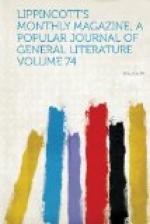“The custom of the school is that on the 12th of December, the Founder’s Day, the head gown-boy shall recite a Latin oration in praise Fundatoris Nostri, and upon other subjects; and a goodly company of old Cistercians is generally brought together to attend this oration; after which[5] ... we adjourn to a great dinner, where old condisciples meet, old toasts are given and speeches are made. Before marching from the oration-hall to chapel the stewards of the day’s dinner, according to old-fashioned rite, have wands put into their hands, walk to church at the head of the procession, and sit there in places of honor. The boys are already in their seats, with smug fresh faces and shining white collars; the old black-gowned pensioners are on their benches; the chapel is lighted, and Founder’s tomb, with its grotesque carvings, monsters, heraldries, darkles and shines with the most wonderful shadows and lights. There he lies, Fundator Noster, in his ruff and gown, awaiting the great Examination Day. We oldsters, be we ever so old, become boys again as we look at that familiar old tomb, and think how the seats are altered since we were here; and how the doctor—not the present doctor, the doctor of our time—used to sit yonder, and his awful eye used to frighten us shuddering boys on whom it lighted; and how the boy next us would kick our shins during service-time; and how the monitor would cane us afterward because our shins were kicked....
“The service for Founder’s Day is a special one. How solemn the well-remembered prayers are!... how beautiful and decorous the rite! how noble the ancient words of the supplication which the priest utters, and to which generations of fresh children and troops of bygone seniors have cried Amen under those arches!"[6]
Having resolved to found a charity which should provide both for young and old, Sutton, who had ample reason fully to appreciate the unprincipled and grasping character of the court, proceeded to take every precaution that sagacity and ingenuity could suggest to keep his money secure from the hands of such harpies as Carr and “Steenie,” and hedge it round with every bulwark possible. Perhaps he consulted “Jingling Geordie,” then planning his own singular scheme,[7] on the point, and got him to persuade the king, always vain of his scholarship, that it would well become him to become patron of an institution having for one of its main objects the education of youth in sound learning. Be this as it may, the fact is certain that a degree of royal and other powerful protection was somehow secured for the institution which for all time prevented its funds from being diverted to other purposes.
Sutton’s bequest of the bulk of his estate to charitable uses was not unnaturally viewed with strong disapprobation by his nephew, one Simon Baxter, for whom he had, however, not neglected to provide, who brought a suit to set aside the will. However, notwithstanding that he had Bacon for his counsel, he failed to interfere with his uncle’s disposition of his estate; the court holding that the claims of kinship had been sufficiently recognized.[8]




